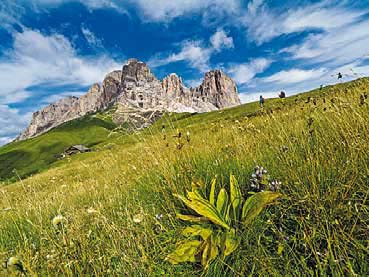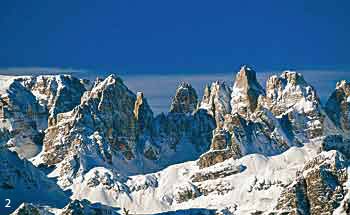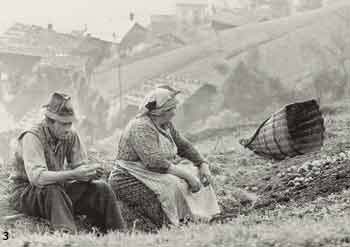| |
 THE DOLOMITES, THE DOLOMITES,
AMONG NATURE AND CULTURE
Annibale Salsa
As often happens, outsiders end up being decisive in the development of an identity. This is also the case for the Dolomites, the geographical, geological and tourist notoriety of which is due to a certain Déodat de Dolomieu who, in the turbulent days of the French Revolution, planned an explorative and search tour in what at that time was called the Venetian Alps on one side, and the Tyrolean Alps on the other side. After the publication in the scientific magazine <<Journal de Physique>> of Dolomieu’s letter, which was addressed to Picot de La Peyrouse (30 January 1791), and therefore officially after the year 1792, the “Monti Pallidi” (Pale Mountains) (as they were referred to in many oral legends and traditions by the population of the Dolomites), adopted their final and lucky name of “Dolomites”; it was with this name that they were to be consecrated as a unique mountain range. The journey by the French Naturalist, whose origins lie in the Dauphiné Region, and whose local sky-line was marked by the Chartreuse-Belledonne Alpine chain, was to become a fundamental stage in the history of knowledge regarding the Alps. The journey was later to be collocated as a continuation of the work of the great Horace Benedict De Saussure from Geneva.
The eighteenth century Enlightenment played a big part in the definition of a different image of the Alps, starting from the western area of the Alpine chain, and then appearing in the eastern area of the Alps, an area that at the time was still enveloped in a magical image of the mountains. 
There has been a level of support for years for the Dolomites to be included in the UNESCO world heritage protected areas list, because of the uniqueness of the mountains’ landscape. In fact, this uniqueness connotes its identity, on the basis of a specific difference compared to the other mountains in the world. However, what does the identity/diversity of the Dolomites consist in? Their nature and their natural history should already be enough to connote its development features. It is through geology and the articulation of its lithology and mineralogy as identified by Dolomieu that the understanding began of the great paradox of mountains that arose from the sea, of coral reefs that, even in their hardy and vertical shapes, communicate a sense of harmony and mellowness. For example, it is possible to evoke “male” and “female” paradigms to represent the shapes of their natural identity in an imaginative and fantastic way, based on the contrast between “phallic” and “mammillary” forms, as unconscious metaphors with a powerful symbolic content.
At first sight, the hardy and vertical shapes of the Dolomites makes one think of assimilation with a masculine image. However, in the kaleidoscope of sensations caused by the alchemies of sight and sound, they reveal themselves as being expressions of a glamour that is completely attributable to a feminine, harmonious and apollonian image. In fact, the boldness of their shapes does not reflect virile roughness, but the elegant and fanciful voluptuousness of the female character, the sensual maquillage of colours that belongs to an ever iridescent appeal.
The image of gentleness attributed to femininity has made the Dolomites an allegory of a domesticated and familiar landscape that is never disturbing or anguishing. The clear criss-crossing of the horizontal lines of the plateaus and the vertical ones of the “crode” or the “vanes”, the alternation of the dark shades of the forests with the lacteous and gravel like ones make the mountains less impending; they seem to present themselves in the form of the great “Cathedrals of the Earth” in the sense proposed by John Ruskin. Vice versa, other mountain ranges in the world do not evoke the “Great Mother” image, even though they have soft forms developed by the abrasive process of glacial masses (smooth rocky humps), and from a morphological point of view have developed wide “breasts”; rather, they evoke an image of strict Fathers, to be feared and kept at a distance, in that kind of anachronistic “battle with the Alps” that the severe mountains of the western Alps inspired in the great westerner Guido Rey.
 The presence of habitations at the foot of the dolomites has also had an important role in the social development of the landscape, accentuating its domestic and intimate aspects. Without wishing to indulge in forced deterministic interpretations, the suspicion arises that the forms nature has bestowed in this area have had a relevant role in fostering the development of a heritage of oral traditions and behavioural patterns in the local population which have great cultural merit and a great aesthetic charm. The presence of habitations at the foot of the dolomites has also had an important role in the social development of the landscape, accentuating its domestic and intimate aspects. Without wishing to indulge in forced deterministic interpretations, the suspicion arises that the forms nature has bestowed in this area have had a relevant role in fostering the development of a heritage of oral traditions and behavioural patterns in the local population which have great cultural merit and a great aesthetic charm.
The culture of mindfulness that comes to mind in looking at the houses, meadows, and cultivations, makes the Dolomite landscape a mix of nature and culture which makes it difficult to separate natural and artificial elements, or objective elements from those that are subjective and part of the community. The different cultures present in the dolomite region, ranging from the German culture to that of the South Tyrol valleys, to the Ladin culture of the ancient Romanized networks, that are located between the three Dolomite Provinces in the form of an inter-linguistic cushion, to the Italian one of the Trento and Belluno valleys, have found a habitat capable of putting the conceptual paradigm of “unity in diversity” into practice, the result of the transformational drive of different strategies for adapting to the environment.
Annibale Salsa
General President of the Club Alpino Italiano (CAI) Italian Alpine Club and lecturer of Anthropology in Genova University
- Francesco Cito, Dolomiti di Fassa - Il Sassolungo
- Giovanni Cavulli, il Gruppo del Brenta visto dalla Paganella
- Photo Flavio Faganello
|
|